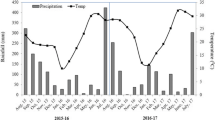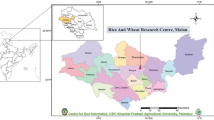Abstract
The minimum disturbance of soil is gaining popularity in different parts of the world because of definite advantages over conventional tillage (CT) especially with respect to rice cultivation. Conventionally, rice is transplanted in puddled soil in which soil is completely broken down and destroyed in presence of standing water to create an impervious layer below the surface so as to hold the rainwater for the rice. Such practice noticeably hampers the growth of the succeeding winter crop grown under conventionally tilled soil because of alteration of soil physical characteristics. Taking into consideration, a field experiment was conducted from 2016 to 2019 to assess the alterations in soil properties resulting from various tillage systems in the cultivation of rice followed by Indian mustard, either through transplanting or direct seeding, after the cultivation of Sesbania aculeata. The experiment was conducted with 20 treatment combinations comprising of five tillage practices combining minimum tillage (MT) and conventional tillage (CT) viz., T1: CT (S: Sesbania)-CT (TR: Transplanted rice)-CT (IM: Indian mustard), T2: MT (S)-CT (TR)-MT (IM), T3: MT (S)-CT (DSR: Direct seeded rice)-CT (IM), T4: MT (S)-MT (DSR)-MT + rice residue @1.5 tha−1 (IM), T5: MT (S)-MT (DSR)-MT (IM) and four weed management practices viz., W1: recommended herbicides (S and IM: pendimethalin 0.75 kg ha−1 pre-emergence; rice: pretilachlor 0.75 kg ha−1 pre-emergence) W2: IWM: integrated weed management (W1 + manual weeding), W3: manual weeding/hoeing, W4: weedy check, laid out in a split-plot design with tillage practices in the main plots and weed management practices in the sub-plots with three replications. Weed management is excluded from the results and discussion section of the paper due to no treatment effect on soil properties. The soil properties studied under the investigation were microbial population, microbial biomass carbon, soil enzymes such as dehydrogenase, phosphomonoesterase and fluorescein di-acetate, soil available NPK, soil organic carbon, bulk density, water holding capacity, total porosity, water stable aggregates, and mean weight diameter of aggregates were significantly changed under direct seeded rice based system as compared to puddled rice based system. Findings of the experiment suggested that by minimizing soil disturbance and residue retention in winter crop not only improved soil properties but also system productivity in terms of average rice equivalent yield (18.60%) of rice-Indian mustard cropping sequence over conventional tillage system. Minimum tillage in Sesbania-direct seeded rice-Indian mustard with rice residue retention improved macro water stable aggregates (> 0.25 mm sized aggregates) (62.08%) and mean weight diameter of aggregates (1.34 mm) at 0–30 cm soil depth as compared to conventional tillage system (60.04% and 1.27 mm, respectively). The same treatment improved total porosity and water holding capacity of 0–15 cm of soil depth by 47.42% and 45.87%, respectively as compared to conventional tillage after three years of investigation. Regression analysis shows that one unit reduction in bulk density increased total porosity of soil by 1.47 units; whereas a unit improvement in total porosity improved water holding capacity of soil by 1.25 units. Other soil properties viz., soil organic carbon (16.75% in 0–15 cm depth and 25.86% in 15–30 cm depth), available nitrogen, phosphorous and potassium (1.04%, 5.40% and 1.54%, respectively); bacterial and fungal population, microbial biomass carbon (49.90%), and activity of dehydrogenase, phosphomonoesterase and fluorescein di-acetate (25.39%, 17.02% and 48.94%, respectively) were also improved under the same treatment over conventional tillage system. A significant (P ≤ 0.01) positive correlation of soil macro-aggregates, water holding capacity, soil microbial biomass carbon with soil organic carbon as well as phosphomonoesterase, dehydrogenase and fluorescein di-acetate activities with soil microbial carbon was observed.





Similar content being viewed by others
Data Availability
Data will be made available on request.
References
Adam, G., & Duncan, H. (2001). Development of a sensitive and rapid method for the measurement of total microbial activity using fluorescein diacetate (FDA) in a range of soils. Soil Biology & Biochemistry, 33, 943–951.
Alijani, K., Bahrani, M. J., Kazemeini, S. A., & Yasrebi, J. (2021). Soil and sweet corn quality responses to tillage, residue, and nitrogen management in Southern Iran. International Journal of Plant Production, 15, 139–150.
Bagnall, D. K., Morgan, C. L. S., Bean, G. M., Liptzin, D., Cappellazzi, S. B., et al. (2022). Selecting soil hydraulic properties as indicators of soil health: Measurement response to management and site characteristics. Soil Science Society of America Journal. https://doi.org/10.1002/saj2.20428
Bodman, G. B. (1942). Nomograms for rapid calculation of soil density, water content, and total porosity relationships. Journal of American Society of Agronomy, 20, 738–741.
Casida, L. E., Klein, D. A., & Santoro, R. (1964). Soil dehydrogenase activity. Soil Science, 98, 371–376.
Dalia, J., Grazina, K., & Ona, A. (2013). The effect of tillage system on soil microbiota in relation to soil structure. Polish Journal of Environmental Studies, 22, 1387–1391.
Gupta, R., & Seth, A. (2007). A review of resource conserving technologies for sustainable management of the rice-wheat cropping systems of the Indo-Gangetic Plains (IGP). Crop Protection, 26, 436–447.
Haynes, R. J., & Francis, G. S. (1993). Changes in microbial biomass C, soil carbohydrates and aggregate stability induced by growth of selected crop and forage species under field conditions. Journal of Soil Science, 44, 665–675.
Jackson, M. L. (1973). Soil Chemical Analysis. Prentica Hall of India Pvt. Ltd., New Delhi.
Kalita, S. (2020). Resource conservation practices in rice (Oryza sativa L.)-mustard [Brassica juncea (L.) Czern and Coss.]cropping sequence [Doctoral dissertation, Assam Agricultural University, Jorhat-785013, India].
Khan, F. U. H., Tahir, A. R., & Yule, I. J. (2001). Intrinsic implication of different tillage practices on soil penetration resistance and crop growth. International Journal of Agriculture and Biology, 1, 23–26.
Kuotsu, K., Das, A., Lal, R., Munda, G. C., Ghosh, P. K., & Ngachan, S. V. (2014). Land forming and tillage effects on soil properties and productivity of rainfed groundnut (Arachis hypogaea L.)-rapeseed (Brassica campestris L.) cropping system in Northeastern India. Soil and Tillage Research, 142, 15–24.
Mann, L. K. (1986). Changes in soil carbon storage after cultivation. Soil Science, 142, 279–288.
Nottidge, D. O., Ojeniyi, S. O., & Asawalam, D. O. (2008). Effect of different food legumes on some soil chemical properties in an acid ultisol of Southeast Nigeria. Nigerian Journal of Soil Science, 18, 54–59.
Package of Practices for Kharif crops of Assam, (2021). Published jointly by Assam agricultural university, Jorhat and Department of Agriculture, govt. of Assam, p. 19.
Package of Practices for Rabi crops of Assam, (2021). Published jointly by Assam agricultural university, Jorhat and Department of Agriculture, govt. of Assam, p. 56.
Piper, C. S. (1950). Soil and plant analysis (pp. 286–287). The University of Adelaide.
Primot, S., Morison, M. V., & Makowski, D. (2006). Predicting the risk of weed infestation in winter oilseed rape crops. Weed Research, 46, 22–33.
Puget, P., Chenu, C., & Balesdent, J. (1995). Total and young organic matter distributions in aggregates of silty cultivated soils. European Journal of Soil Science, 46, 449–459.
Sharma, A. R., Jat, M. L., Saharawat, Y. S., Singh, V. P., & Singh, R. G. (2012). Conservation agriculture for improving productivity and resource-use efficiency: Prospects and research needs in Indian context. Indian Journal of Agronomy, 57(3), 131–140.
Silva, A. M. da, Urban, R. C., Manfre, L. A., Brossard, M., & Moreira, M. Z. (2017). Soil quality attributes related to urbanization in Brazilian watershed. Journal of Environmental Engineering and Landscape Management, 25(4), 317–328.
Six, J., Elliott, E. T., & Paustian, K. (1999). Aggregate and soil organic matter dynamic under conventional and no-tillage systems. Soil Science Society of America Journal, 63, 1350–1358.
Six, J., Elliott, E. T., & Paustian, K. (2000). Soil macroaggregate turnover and microaggregate formation: A mechanism for C sequestration under no-tillage agriculture. Soil Biology & Biochemistry, 32, 2099–2103.
Subbiah, B. V., & Asija, G. L. (1956). A rapid procedure for the determination of available nitrogen in soils. Current Science, 25, 256–260.
Tabatabi, M. A., & Bremner, J. M. (1969). Use of P-nitrophenol phosphate for assay of soil phosphatase activity. Soil Biology & Biochemistry, 1, 301–307.
Thomas, A. G., Derksen, D. A., & Blackshaw, R. E. (2004). A multi-study approach to understanding weed population shifts in medium to long-term tillage systems. Weed Science, 52, 874–880.
Van Bavel, C. H. M. (1949). Mean weight diameter of soil aggregates as a statistical index of aggregation. Soil Science Society of America Journal, 14, 20–23.
Walkley, A., & Black, C. A. (1934). An examination of the method for determination of soil organic matter and proposed modification of the chromic acid titration method. Soil Science, 37, 29–39.
Wei, T., Zhang, P., Wang, K., Ding, R., Yang, B., & Nie, J. (2015). Effects of Wheat Straw Incorporation on the Availability of Soil Nutrients and Enzyme Activities in Semiarid Areas. PLoS ONE, 10(4), 120–135.
Yoder, R. E. (1936). A direct method of aggregate analysis of soils and a study of physical nature of erosion losses. Agronomy Journal, 28, 337–351.
Acknowledgements
The author also acknowledges AICRPWM (All India Co-ordinated Research Project on Weed Management, AAU, Jorhat and Jabalpur, India) for providing professional guidance as well as material support.
Author information
Authors and Affiliations
Corresponding author
Ethics declarations
Competing Interest
The authors declare that they have no known competing financial interests or personal relationships that could have appeared to influence the work reported in this paper.
Rights and permissions
Springer Nature or its licensor (e.g. a society or other partner) holds exclusive rights to this article under a publishing agreement with the author(s) or other rightsholder(s); author self-archiving of the accepted manuscript version of this article is solely governed by the terms of such publishing agreement and applicable law.
About this article
Cite this article
Kalita, S., Deka, J., Kurmi, K. et al. Rice Equivalent Yield and Soil Properties as Influenced by Conventional and Minimum Tillage System in Rice Based Cropping Sequence in North-East India. Int. J. Plant Prod. (2024). https://doi.org/10.1007/s42106-024-00297-0
Received:
Accepted:
Published:
DOI: https://doi.org/10.1007/s42106-024-00297-0




